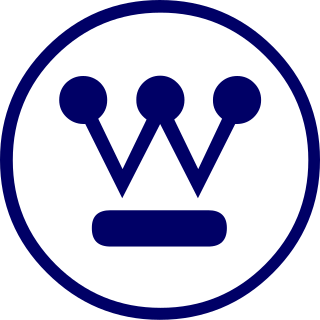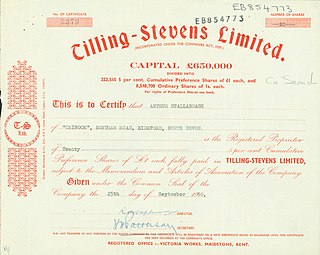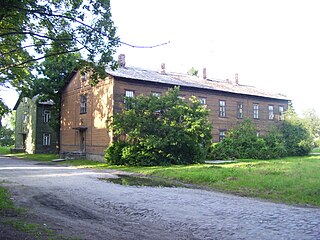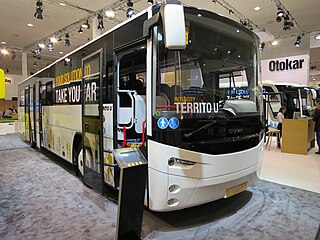
The Westinghouse Electric Corporation was an American manufacturing company founded in 1886 by George Westinghouse and headquartered in Pittsburgh, Pennsylvania. It was originally named "Westinghouse Electric & Manufacturing Company" and was renamed "Westinghouse Electric Corporation" in 1945. Through the early and mid-20th century, Westinghouse Electric was a powerhouse in heavy industry, electrical production and distribution, consumer electronics, home appliances and a wide variety of other products. They were a major supplier of generators and steam turbines for most of their history, and was also a major player in the field of nuclear power, starting with the Westinghouse Atom Smasher in 1937.

The Ganz Machinery Works Holding is a Hungarian holding company. Its products are related to rail transport, power generation, and water supply, among other industries.

The Graphophone was the name and trademark of an improved version of the phonograph. It was invented at the Volta Laboratory established by Alexander Graham Bell in Washington, D.C., United States.

Naissaar is an island in Estonia. It is located in the Gulf of Finland, northwest of the capital city Tallinn, and is administratively part of Viimsi Parish. The island has an area of 18.6 square kilometres. It is 8 kilometres long and 3.5 kilometres wide, and lies about 8.5 kilometres from the mainland. The highest point on the island is Kunilamägi, which is 27 metres above sea level. The island consists predominantly of coniferous forest and piles of stones and boulders. In 2020, the island had a population of 17; in 2011 the island had about 35 permanent residents and some summer residents.

Tilling-Stevens was a British manufacturer of buses and other commercial vehicles, based in Maidstone, Kent. Originally established in 1897, it became a specialist in petrol-electric vehicles. It continued as an independent manufacturer until 1950, when it was acquired by the Rootes Group.
Dick, Kerr and Company was a locomotive and tramcar manufacturer based in Kilmarnock, Scotland and Preston, England.

Kiviõli is an industrial town in Ida-Viru County, Estonia, established in 1922. The main industry in the town is oil shale mining, which gives the town its name.

Voldemar Väli was an Estonian two-time Olympic medalist in Greco-Roman wrestling.

An engine–generator is the combination of an electrical generator and an engine mounted together to form a single piece of equipment. This combination is also called an engine–generator set or a gen-set. In many contexts, the engine is taken for granted and the combined unit is simply called a generator. An engine–generator may be a fixed installation, part of a vehicle, or made small enough to be portable.

Kopli is a subdistrict of the district of Põhja-Tallinn in Tallinn, the capital of Estonia. It is located on the Kopli Peninsula and is bordered by parts of the Tallinn Bay, the Kopli Bay to the southwest and the Paljassaare Bay to the north. Kopli has a population of 7,240. Kopli's former German name until 1918 was Ziegelskoppel.

TU2 (ТУ2) is a Soviet narrow gauge diesel locomotive for the track gauge of 750 mm

Põhja-Tallinn is one of the eight administrative districts of Tallinn, the capital of Estonia.

Kalamaja is a subdistrict of the district of Põhja-Tallinn in Tallinn, the capital of Estonia. It is located just northwest of the historical town centre, on the coast of the Tallinn Bay. Kalamaja has a population of 9,820.

The automotive industry in Turkey plays an important role in the manufacturing sector of the Turkish economy. The companies operating in the Turkish automotive sector are mainly located in the Marmara Region, especially Bursa.

Ahtme Power Plant was an oil shale-fired power plant in Ahtme, Kohtla-Järve, Estonia. It was owned by VKG Soojus, a subsidiary of Viru Keemia Grupp. Until the end of 2012, it supplied with heat Ahtme district of Kohtla-Järve and Jõhvi.

The Tallinn Power Plant is a former power plant located in Tallinn, Estonia. Construction of the power plant was initiated by Volta company and it was decided by the Tallinn City Council in 1912 after the work of special committee established in 1909. The plant was located next to the Tallinn Gas Factory at the location of the former Stuart fortress. The plant was designed by Volta and the architect was Hans Schmidt. Originally it used three Laval-type 250 horsepower (0.19 MW) steam turbines and three 250 horsepower (0.19 MW) electric generators—all produced by Volta. Two coal-fired boilers were manufactured by AS Franz Krull. The power plant was opened on 24 March 1913, and originally it was fired by coal. In 1919–1920 the plant was expanded and transferred to peat and wood. In 1924 the power plant was switched to oil shale. It was the first power plant in the world to employ oil shale as its primary fuel. In 1939, the plant achieved capacity of 22 MW.

The Tram System of Tallinn is the only tram system in Estonia. Together with the four-route trolleybus network (et), the four tram lines, with a total length of 19.7 km, are arranged in a roughly cross-shaped layout, providing a backbone for the public transport network in the Estonian capital. Four of the five routes meet up at the stop Hobujaama, in the city center. Trams are unidirectional, one-sided and single-person operated, and much of the network runs on segregated two-way track.

The Taean Machine Complex is machinery factory in Taean-dong, Taean-guyŏk, Namp'o Special City, North Korea producing a wide array of electric machinery for industrial and household use.

Dvigatel was a metal industry company located in Lasnamäe, Tallinn, Estonia. Dvigatel existed 1897–2007. Its headquarters were located in Tallinn and Sankt Peterburg. Infrastructure of Dvigatel is partly preserved nowadays and is situated in Industry park of Dvigatel





















